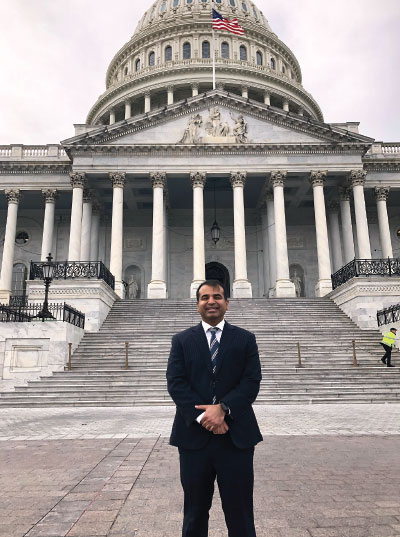APA Member Speaks on Pediatric MH Crisis in Congressional Briefing
Abstract
Experts spoke of the barriers to care, the importance of collaboration, and the needs of diverse populations.

During the briefing, Anish Ranjan Dube, M.D., M.P.H., raised his concerns about the separation of minors from their families at the U.S. border, which he said will have long-term pediatric mental health impacts.
The Pennsylvania Department of Insurance has fined Aetna Inc.$190,000 for policies that the department says violate the federal mental health parity law, especially regarding coverage of autism and substance use disorders.
Long before Anish Ranjan Dube, M.D., M.P.H., began treating the patient, there were multiple clues that she needed serious help.
She was truant from school, so someone from the school system could have investigated. The health care system might have noticed she needed help, but she hadn’t had any real medical care in years. There was reported domestic violence in her home, so maybe police officers could have noticed she needed treatment.
But none of that ever happened. Dube, vice chair of APA’s Council on Children, Adolescents, and Their Families, is a child and adolescent psychiatrist in the juvenile justice system in Orange County, Calif. By the time the patient entered his care, she was psychotic, hearing voices, and delusional, and she had already committed a crime.
Dube described this young woman’s story on Capitol Hill during an early February briefing coordinated by Congresswoman Katie Porter (D-Calif.) titled “The Pediatric Mental Health Crisis.” Porter invited mental health professionals and experts from across the country to discuss the challenges in pediatric mental health care, as well as identify solutions to increase access to care.
Porter has been APA’s champion on mental health parity. She introduced the Mental Health Parity Compliance Act in June 2019, which ensures health plans comply with an existing federal law that requires they cover mental and substance use disorder treatment with no more restrictions than their coverage of other medical conditions.
Other speakers on the panel included Heather C. Huszti, Ph.D., chief psychologist of Children’s Hospital of Orange County; Alfiee Breland-Noble, Ph.D., M.H.Sc., founder of the AAKOMA Project; Thomas Boat, M.D., a professor of pediatrics and dean emeritus at Cincinnati Children’s Hospital Medical Center; and Eve Reider, Ph.D., an associate director for prevention research at the National Institute of Mental Health (NIMH).
During his talk, Dube described the difficulties working in “silos” as a child and adolescent psychiatrist. Though he is trained to treat autism, develomental disabilities, and substance use disorders, reimbursement for treating these conditions can vary—even though diagnoses often overlap.
His patients often interact with various systems, such as primary care, schools, and social services, yet communication to coordinate care between these systems can be hugely difficult.
The shortage of child and adolescent psychiatrists is another massive barrier for patients. In the case of the patient in the story he shared, he explained that she was coming from a rural area. “The only child and adolescent psychiatrist who was available to her was me, and I was in the justice system,” he said during the briefing.
“It’s extremely frustrating,” he told Psychiatric News. Systems should be incentivized to work together, he said, to create a healthy population. “We’re all in this together to keep this person healthy.”
One solution to some of these barriers, Dube noted, might be the Collaborative Care Model, for which APA has strongly advocated and which emphasizes integrating mental health and primary care. The model involves care coordination of patients seen in a primary care setting and regular caseload reviews with a psychiatric consultant. “A lot of young folks, and people in general, are a lot more comfortable accessing their primary care [physician] than they would be accessing specialty mental health services,” Dube said.
He also encouraged physicians to incorporate early onset psychosis treatments and supports to prevent full onset of psychosis and improve long-term outcomes. “We know if we catch folks early, treat them early, and provide them with services early, their outcomes are far better downstream. And they’re much more likely to be productive members of society,” Dube said.
A theme of the panel’s discussion was the unique needs of diverse populations. Reider of NIMH noted that American Indians and Alaska Natives have the highest rates of suicide among racial and ethnic groups in the United States. Between 2003 and 2014, more than one-third of suicides in this population occurred among youth aged 10 to 24 years.
“There is a need for prevention interventions to stem the increasing rates by reducing risk for its occurrence in the first place and for treating those experiencing mental illness,” Reider said.
During his talk, Boat brought up recommendations in the September report from the National Academies of Sciences, Engineering, and Medicine on improving child and youth mental, emotional, and behavioral health. The report’s appendix lists the recommendations of 19 similar reports the organization has published in the last 10 years. Many of the recommendations, Boat pointed out, are similar, such as integrating health services and increasing economic resources so families can meet their children’s basic health needs.
“The question really is: Do we need more recommendations?” Boat said. “I think we know how to, at least, get started. What we need is action.” ■



